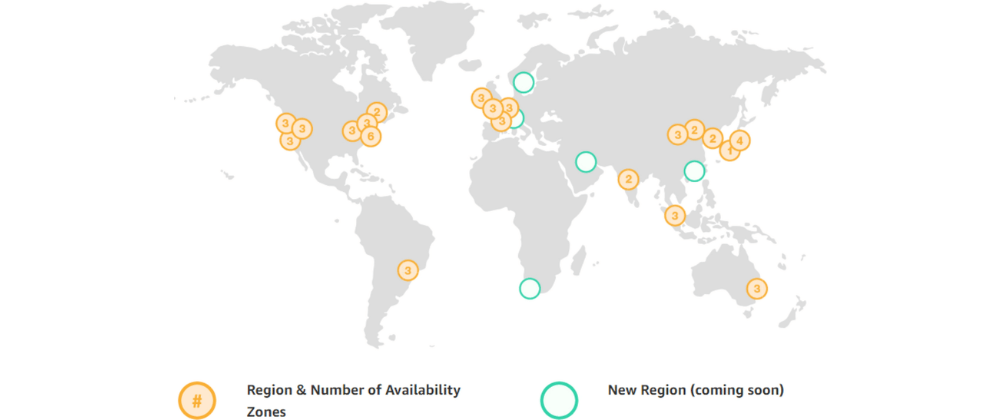Note:- Images are taken from amazon official website
Let's see about AWS Global Infrastructure,
What is AWS Cloud Infrastructure?
AWS Cloud Infrastructure is a more secure, extensive and reliable service by cloud provider. where user can deploy their application in less than a minute in a region( i.e., Geographical area) and make it available globally and user can also deploy their particular application, which is close to their large population users to provide High latency- AWS have AWS Local Zones and to provide services with ultra-High-latency- AWS have AWS Wavelength Zones.
Region:-
Region is a geographical area or location from where AWS serves its services to its end users or an customer. At present, we have 26 Regions and each region have two or more Availability Zones(AZ).
A grouping of AWS Resources or services within a geographical location is called a Region. To understand it, clearly - some AWS Services are not available in India. It will be available in Northern Virginia Region. So, if we want to use that unavailable services in India, we can go with Northern Virginia Region.
Availability Zones:-
As we said before, there are one or more availability Zones within in a region. Availability zones is nothing, but an Physical Data Centers located in various locations within a region. At present, there are two availability Zones(AZ) in India one is at Mumbai and another one is at Chennai and Mumbai is an main center.
Advantages of having Availability Zones is to reduce Redundancy of services provided by AWS and to provide High Speed Access of AWS Resources or Services to customers.
To control fault tolerance and failure of particular Availability Zone, customer can Backup their application server or its database in another availability Zone. So, their end users can access that application without any delay.
We will take an Scenario, If we have PHP-web Application running in two web servers and in one database server. if the connectivity of application server to the database in that particular availability zone fails, application will not go down instead backup of its database connectivity in another Availability Zone will continue to serve the user.
Edge Locations:-
Edge locations are Content Delivery Network(CDN) end points, it's just aN expansion of a region.
We will take an Scenario, if we are accessing the server which is at London from India there can be time delay to serve the content so, AWS came up with Edge Locations where data / content are cached and stored.
let's return back to our scenario:- When user request to content which is in London server, it will search in edge location and if data not found then, it will go to London server and return to Edge location it will be cached and stored. If second time any user try to access same content, again it will not go to London Server, instead it will return the content from edge locations.
You can also refer to this, to know more information about Regions, Availability Zones and edge Locations https://aws.amazon.com/about-aws/global-infrastructure/
AWS Local Zones:-
AWS Local Zones serve compute, storage and networking and other AWS Services to end users at the High speed. With AWS Local Zones, you can deploy and run High Demanding applications like Media & Entertainment applications, gaming applications, etc., without low latencies to end users.
AWS Local Zones provide High Bandwidth and secure connection between local workloads and those in AWS Region.
Example:- Netflix
In AWS Local Zones we will be moving our deployed application from our Virtual Private network to AWS Local Zones securely and serve to end users.
AWS Wavelength Zones:-
AWS Wavelength Zones are there to provide ultra-low latency applications across 5G Networks. Applications like video streaming, for Machine Learning Models, etc., are deployed in AWS Wavelength Zones.
Application part which is need to be deployed in Wavelength Zones, first we will move Virtual Private Network to Wavelength Zone and then we will create an Amazon EC2 instance in the desired availability Zone within a Region.
we can also deploy specific part of application to wavelength Zone and keep rest of application in the AWS Region(i.e., under desired Availability Zone).
Conclusion:-
Next, I will be moving to IAM - Identity Access Management Concept.









Top comments (0)